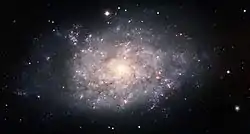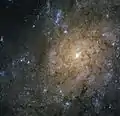NGC 7793
NGC 7793 is a flocculent spiral galaxy about 12.7 million light-years away in the constellation Sculptor. It was discovered in 1826 by James Dunlop.[5]
| NGC 7793 | |
|---|---|
 NGC 7793 | |
| Observation data (J2000 epoch) | |
| Constellation | Sculptor |
| Right ascension | 23h 57m 49.8s[1] |
| Declination | −32° 35′ 28″[1] |
| Helio radial velocity | 227 ± 2 km/s[1] |
| Distance | 12.7 ± 1.3 Mly (3.9 ± 0.4 Mpc)[2][3][4] |
| Apparent magnitude (V) | 10.0[1] |
| Characteristics | |
| Type | SA(s)d[1] |
| Apparent size (V) | 9′.3 × 6′.3[1] |
| Other designations | |
| PGC 73049[1] | |
Galaxy group information
NGC 7793 is one of the brightest galaxies within the Sculptor Group, a group of galaxies in the constellation of the same name. The group itself is an elongated, loosely bound group of galaxies with the Sculptor Galaxy (NGC 253) and its companion galaxies forming a tightly-bound core of galaxies near the center.[2]
Supernova 2008bk
On March 25, 2008, SN 2008bk was discovered in NGC 7793.[6] At apparent magnitude 12.5, it became the 2nd brightest supernova of 2008.[7] The progenitor of this supernova was a Red Supergiant, observed only 547 days prior to the explosion.
Black hole P13 in outer spiral
Jets from a black hole named P13 power a large nebula named S26 in the outer spiral of this galaxy. Recently, the mass of P13 was determined to be less than 15 solar masses, and its companion star is estimated to be around 20 solar masses. The two orbit each other in 64 days.[8] Based on this estimate, P13 is stripping material away from a nearby star about ten times faster than was previously believed to be physically possible. If correct, this observation would show flaws in theories that a black hole's mass and rate of consumption are a fixed relationship.[9][10]
Gallery
 Spiral arms and small central bulge[11]
Spiral arms and small central bulge[11] Image of the chaotic spiral galaxy NGC 7793
Image of the chaotic spiral galaxy NGC 7793
References
- "NASA/IPAC Extragalactic Database". Results for NGC 7793. Retrieved 2006-11-21.
- I. D. Karachentsev; E. K. Grebel; M. E. Sharina; A. E. Dolphin; et al. (2003). "Distances to nearby galaxies in Sculptor". Astronomy and Astrophysics. 404 (1): 93–111. arXiv:astro-ph/0302045. Bibcode:2003A&A...404...93K. doi:10.1051/0004-6361:20030170.
- I. D. Karachentsev; V. E. Karachentseva; W. K. Hutchmeier; D. I. Makarov (2004). "A Catalog of Neighboring Galaxies". Astronomical Journal. 127 (4): 2031–2068. Bibcode:2004AJ....127.2031K. doi:10.1086/382905.
- Karachentsev, I. D.; Kashibadze, O. G. (2006). "Masses of the local group and of the M81 group estimated from distortions in the local velocity field". Astrophysics. 49 (1): 3–18. Bibcode:2006Ap.....49....3K. doi:10.1007/s10511-006-0002-6.
- Dunlop James (1828). "A Catalogue of Nebulae and Clusters of Stars in the Southern Hemisphere observed in New South Wales" (PDF). Philosophical Transactions of the Royal Society. 118: 113–151. Bibcode:1828RSPT..118..113D. doi:10.1098/rstl.1828.0010. JSTOR 107841.
- David Bishop. "Supernova 2008bk in NGC 7793". supernovae.net (International Supernovae Network). Archived from the original on 2011-09-27. Retrieved 2010-06-07.
- David Bishop. "Bright Supernovae - 2008". supernovae.net (International Supernovae Network). Archived from the original on 2011-09-27. Retrieved 2010-06-07.
- "Hungry black hole eats faster than thought possible". Archived from the original on 2016-03-17. Retrieved 2014-10-10.
- Black hole emitting a giant gas bubble 1000 light-years wide
- Small Black Hole Has Huge Appetite That Defies Theory October 8, 2014 | by Lisa Winter
- "Jets and explosions in NGC 7793". www.spacetelescope.org. ESA/Hubble. Retrieved 22 September 2014.